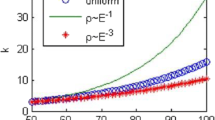Abstract
The network lifetime is limited by key nodes in wireless sensor networks (WSNs). These nodes around the base station undertake a heavy load and die earlier than the others, so an energy hole emerges. In this study, an energy-balanced strategy that contributes to redistributing energy consumption of the network is proposed for WSNs through the innovative use of complex networks synchronization theory. The betweenness centrality in complex networks is used to measure the importance of the node in the network. Constructing energy consumption synchronization functions and decreasing the maximum betweenness of the node in this study improves the synchronization capacity of energy consumption and weakens the effect of key nodes on the performance of the network, the effect of key edges is also investigated in this study. Experiment results show that compared with other algorithms, the proposed strategy delays the appearance of the first death node, therefore prolongs the lifetime of the network effectively and helps achieve balance in the energy consumption of nodes.







Similar content being viewed by others
References
Ramesh, M. V. (2014). Design, development, and deployment of a wireless sensor network for detection of landslides. Ad Hoc Networks, 13(SI), 2–18.
Emanuele, I., Giovanni, G., Francesco, M., et al. (2012). Design and implementation of a landslide early warning system. Engineering Geology, 147(2012), 124–136.
Zulkifli, C. Z., Hassan, H. N., Ismail, W., et al. (2015). Embedded RFID and wireless mesh sensor network materializing automated production line monitoring. Acta Physica Polonica A, 128(2B), B86–B89.
Jaguey, J. G., Villa-Medina, J. F., Lopez-Guzman, A., et al. (2015). Smartphone Irrigation Sensor. IEEE Sensors Journal, 15(9), 5122–5127.
Unluturk, M. S., & Kaan, K. (2012). Integration of RFID and web service for assisted living. Journal of Medical Systems., 36(4), 2371–2377.
Zhang, Z., Udyant, K., & Michael, N., et al. (2011). Design of an unobtrusive wireless sensor network for nighttime falls detection, In IEEE engineering in medicine and biology society conference proceedings (pp 5275–5278).
Li, J., & Mohapatra, P. (2005). An analytical model for the energy hole problem in many-to-one sensor networks. In IEEE VTS vehicular technology conference proceedings (pp. 2721–2725).
Nishikawa, T., Motter, A. E., Lai, Y. C., & Hoppensteadt, F. C. (2003). Heterogeneity in oscillator networks: are smaller worlds easier to synchronize? Physical Review Letters, 91(1), 014101.
Hong, H., Kim, B. J., Choi, M. Y., & Park, H. (2004). Factors that predict better synchronizability on complex networks. Physical Review E, 69(6), 067105.
Watts, D. J., & Strogatz, S. H. (1998). Collective dynamics of small-world networks. Nature, 393(6684), 440–442.
Helmy, A. (2003). Small Worlds in wireless networks. IEEE Communications Letters, 7(10), 490–492.
Zheng, G., & Liu, Q. (2010). Overview of small world network model in wireless sensor networks. Journal of Computational Information Systems, 6(10), 3471–3479.
Hawick, K. A., & James, H. A. (2003). Small-world effects in wireless agent networks. In Technical report CSTN-001 (pp. 155–164).
Meng, A., & Chen, P. (2008). Construction to heterogeneous sensor networks based on effect of small world. Computer & Digital Engineering, 36(9), 98–100.
Liu, M. (2007). Approach to construction of wireless sensor networks with small world effect. Electronic Measurement Technology, 30(4), 37–40.
Matthias, R. (2007). Small worlds: Strong clustering in wireless networks. Networking and Internet Architecture, 6(3), 1–10.
Zhang, X. (2009). Model design of wireless sensor network based on scale-free network theory. In 5th international conference on wireless communications, networking and mobile computing, WiCOM (pp. 1–4).
Zhu, H., Luo, H., Peng, H., Li, L., & Luo, Q. (2009). Complex networks-based energy-efficient evolution model for wireless sensor networks. Chaos, Solitons and Fractals, 41, 1828–1835.
Parth, H., & Rudra Dutta, P. (2012). Centrality-based power control for hot-spot mitigation in multi-hop wireless networks. Computer Communications, 35, 1074–1085.
Cuzzocrea, A., Papadimitriou, A., Katsaros, D., et al. (2012). Edge betweenness centrality: A novel algorithm for QoS-based topology control over wireless sensor networks. Journal of Network and Computer Applications, 35(2012), 1210–1217.
Zhang, D., Li, G., Zheng, K., Ming, X., & Pan, Z.-H. (2014). An energy-balanced routing method based on forward-aware factor for wireless sensor networks. IEEE Transactions on Industrial Informatics, 10(1), 766–773.
Chen, G., Li, C., Ye, M., & Jie, W. (2009). An unequal cluster-based routing protocol in wireless sensor networks. Wireless Networks, 15, 193–207.
Zhao, H., Guo, S., Wang, X., et al. (2015). Energy-efficient topology control algorithm for maximizing networklifetime in wireless sensor networks with mobile sink. Applied Soft Computing, 34, 539–550.
Tunca, C., Isik, S., Donmez, M. Y., et al. (2015). Ring routing: An energy-efficient routing protocol for wireless sensor networks with a mobile sink. IEEE Transactions on Mobile Computing, 14(9), 1947–1960.
Liu, T., Li, Q., & Liang, P. (2012). An energy-balancing clustering approach for gradient-based routing in wireless sensor networks. Computer Communications, 35, 2150–2161.
Abd, M. A., Majed Al-Rubeaai, S. F., Singh, B. K., et al. (2015). Extending wireless sensor network lifetime with global energy balance. IEEE Sensors Journal, 15(9), 5053–5063.
Zhang, J., Liu, Y., & Li, B., et al. (2015). Achieving energy-balance with unequal clustering under single-hop transmission in wireless sensor networks. In The 14th international conference on wireless networks, ICWN’15 (pp. 146–152).
Chen, L., Mao, Y., Chen, D., et al. (2007). Topology control of wireless sensor networks under an average degree constraint. Chinese Journal of computer, 30(9), 1544–1550.
Heinzelman, W. B. (2000). Application-specific protocol architectures for wireless networks. PhD thesis, Massachusetts Institute of Technology.
Acknowledgements
The authors express sincere appreciation to the editors and the anonymous reviewers for their helpful comments.
Funding was provided by People’s Government of Jilin Province (Grant No. 20140204063GX).
Author information
Authors and Affiliations
Corresponding author
Rights and permissions
About this article
Cite this article
Zhang, J., Feng, X. & Liu, Z. Energy-Balanced Strategy for Wireless Sensor Networks by Utilizing Complex Networks Synchronization Theory. Wireless Pers Commun 97, 4145–4159 (2017). https://doi.org/10.1007/s11277-017-4717-y
Published:
Issue Date:
DOI: https://doi.org/10.1007/s11277-017-4717-y




